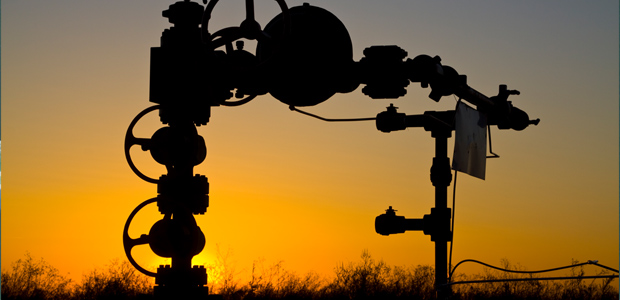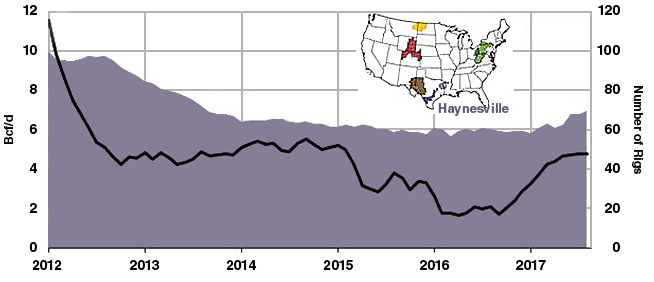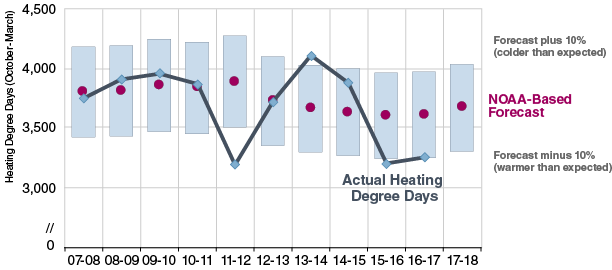
Natural Gas Forecasts
Haynesville Gas Production On The Rise
WASHINGTON–Increased drilling activity and higher overall well production rates are raising Haynesville Shale natural gas production to the highest levels in four years, according to the U.S. Energy Information Administration.
Marketed natural gas production from the Haynesville reached 6.9 billion cubic feet a day in September after remaining essentially flat around the 6.0 Bcf/d mark for the previous three years (Figure 1). The growth in Haynesville output is attributable to an increase in the number of active drilling rigs starting late in 2016, and a trend toward higher per-well initial productivities, EIA explains.
The United States Geological Survey estimates that the Haynesville Shale holds 174.6 trillion cubic feet of technically recoverable resources, the second-largest gas basin in the United States after only Appalachia.
FIGURE 1
Haynesville Marketed Gas Production and Rig Count
Source: U.S. Energy Information Administration and Baker Hughes
From 2009 to 2012, the Haynesville was the largest shale gas-producing region in the country. In November 2011, Haynesville regional production reached a record 10.4 Bcf/d. Beginning in early 2013, however, Haynesville output began to slip as natural gas prices declined. It was surpassed that year by Marcellus/Utica production. By late 2015, EIA adds, shale gas production from relatively liquids-rich plays such as the Eagle Ford and Permian Basin also began surpassing production from the Haynesville region.
Compared with Appalachian resources, Haynesville natural gas reservoirs are deeper, with formation depths ranging between 10,000 and 14,000 feet. EIA notes that the Haynesville Shale also is slightly thinner than the Marcellus or Utica, with thicknesses between 100 and 350 feet across the play.
Per-well production from new wells completed in the Haynesville play have been increasing over the past few years, the agency reports. “Operators in the region have increased the lateral lengths of horizontal wells beyond 7,000 feet, added more fracturing stages, and significantly increased the quantity of proppant used in completion activities,” EIA states.
Winter Outlook
EIA forecasts higher prices for natural gas, heating oil and propane this winter because of expected colder weather. A return to more typical temperatures from October through March is expected to elevate Henry Hub spot prices to an average $3.30/Mcf this winter, a 5 percent increase from last winter. The agency says average consumer price increases vary by fuel, with natural gas expenditures forecast to rise by 12 percent, home heating oil by 17 percent, electricity by 8 percent, and propane by 18 percent.
“Based on the most recent forecast of heating degree days from the National Oceanic & Atmospheric Administration, temperatures this winter are expected to be colder than last winter across the country,” an EIA report reads. “However, last winter was significantly warmer than normal. On average, temperatures across the United States are expected to be 13 percent colder than last winter, with forecasts ranging from 27 percent colder in the South to 4 percent colder in the West.”
Despite the expectation of colder temperatures compared with last year, temperatures across the eastern United States are forecast to be comparable to the average of the previous five winters. In the West, temperatures are forecast to be 7 percent colder than the previous five-winter average.
“However, recent winters provide a reminder that weather can be unpredictable; the winters of 2013-14 and 2014-15 were generally colder than normal, while the past two winters were much warmer than normal,” EIA points out.
Forecast By Fuel Type
Nearly half of all U.S. households are heated primarily by natural gas. EIA expects a 9 percent increase in natural gas consumption this winter, with the average household consuming 62 Mcf. The increase in consumption reflects forecast heating degree days that are 13 percent higher than last winter (Figure 2).
Although residential natural gas prices are forecast to be only 2 percent higher this winter, EIA says Henry Hub spot prices should average 5 percent higher, reflecting higher expected use of natural gas across all consuming sectors and ramping natural gas exports.
If the winter turns out to be 10 percent colder than forecast, EIA projects that residential natural gas consumption would be 18 percent higher, with average expenditures 20 percent higher than last winter. Under a 10 percent warmer-than-forecast scenario, which would still be colder than last winter, EIA projects natural gas consumption would be less than 1 percent higher than last winter, and prices would average 2 percent higher than last winter.
The differential between Appalachian and Louisiana pricing hubs is expected to persist, the agency says. Pipeline constraints in the Appalachian region continue to pose challenges for natural gas produced from the Marcellus and Utica shales.
Two pipeline projects that had been expected to come online heading into winter to alleviate some of the constraints to moving natural gas to demand centers in the Midwest have been delayed. The 3.25 billion cubic feet per day Rover Pipeline was slated for completion in November 2017, but its current in-service date is the first quarter of 2018, according to EIA. Meanwhile, the in-service date of the Nexus Gas Transmission Project to deliver 1.5 Bcf/d out of the Utica region also has been pushed back to the first quarter of 2018, EIA updates.
Last winter, the United States was a net importer of natural gas, averaging 0.6 Bcf/d. However, EIA says it expects the United States to be a natural net gas exporter this winter for the first time, with net exports averaging 1.4 Bcf/d. Both increased pipeline capacity to Mexico and Gulf Coast liquefied natural gas export capacity are supporting higher levels of exports compared with last year.
EIA expects heating oil prices to be higher than last winter because of stronger crude oil prices and higher distillate fuel margins. Retail heating oil is forecast to average $0.25/gallon (10 percent) higher than last winter, with 6 percent greater consumption. Despite the increased forecast expenditures, EIA says it still expects average household heating oil expenditures this winter to be about 15 percent lower than the five-year winter average.
Propane prices are forecast to average 6 percent higher than last winter, with 5 percent greater consumption. Propane inventories enter the heating season at levels below the five-year average after beginning last winter well above the five-year average, according to EIA. It forecasts propane production at natural gas plants and refineries to be 7 percent higher this winter, while total propane consumption is expected to be 2 percent higher and net exports 4 percent lower than winter 2016-17.
For other great articles about exploration, drilling, completions and production, subscribe to The American Oil & Gas Reporter and bookmark www.aogr.com.
















